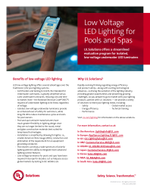
Pool & Spa Low Voltage LED Lighting
UL Solutions offers safety testing and certification and performance testing for the wide variety of luminaires that exist for outdoor and landscape lighting.
In today’s market, outdoor and landscape lighting encompasses many applications from decorative elements in residential yards to lighting that increases visibility and safety in public spaces. Outdoor lighting can be categorized into distinct types:
Traditional line voltage luminaires will have housings that prevent water intrusion and can be mounted on the side of buildings, on poles or bollards, or directly on or recessed into the ground.
Low voltage luminaires are typically used to illuminate landscape pathways, outdoor patios and similar locations where the lighting needs are more for enhanced visibility or aesthetic enjoyment. These luminaires can be installed as a system or as separate luminaires mated with compatible power units. The National Electrical Code, Article 411, limits the power units to no more than 25 A per circuit, with each circuit typically supplying multiple luminaires in a string configuration.
PV-powered luminaires are the newest entry to this field. While each luminaire may be a bit bulkier than those supplied remotely, they have the distinct advantage of being able to be installed anywhere without any interconnecting wiring or cables to worry about. The range of sizes and light output capacity is rapidly expanding, with few inherent constraints on potential applications. Advances in both battery technology and PV module design suggest that ample opportunities with this product type can be harnessed.
We can provide safety evaluations for all of these luminaire types customized for the particular hazards and safeguards associated with their unique power sources. High intensity discharge (HID) and incandescent technology is still used for some line and low voltage outdoor lighting, but PV powered luminaires exclusively use LED technology. Since low voltage luminaires, whether supplied by a remote power unit or an integrated PV module, present no risk of electric shock injury they are subject to a far more abbreviated evaluation than their line voltage counterparts.
We offer a full range of outdoor lighting testing and certification services, for both safety and performance, through our worldwide network of laboratories and engineering facilities.
Line voltage luminaires are evaluated for compliance to UL 1598, the Standard for Safety of Luminaires, including the applicable wet location requirements. These requirements are fully harmonized with the Canadian standard CSA C22.2 No. 250.0. Every UL certification project will provide for installation approval in both the U.S. and Canada. For enclosures made of polymeric material, additional evaluations are needed to assess their ability to retain integrity after exposure to ultraviolet light and very low temperatures. Additionally, many of these products are evaluated for ingress protection (IP) so they may be able to obtain an applicable IP rating per EN 60529, signifying the product’s ability to withstand penetration from moisture and dust.
Low voltage lighting can be evaluated as a complete system or as separate low voltage luminaires and power units. Over the past two decades, and increasingly with the expansion of LED technology, manufacturers have more commonly focused on either luminaires or power units. The applicable standards — UL 1838, the Standard for Low Voltage Landscape Lighting Systems, and UL 2108, the Standard for Low Voltage Lighting Systems — have been revised to more easily allow these parts to be mated in the field through marked ratings. They are also well aligned with the applicable Canadian standards, CSA C22.2 No. 250.2 for lighting systems and 250.7 for extra low voltage landscape lighting systems. The power units are evaluated for risks of fire and electric shock under a range of use conditions, while the luminaires require evaluation only for fire risk because the power units are limited to 15 Vac or 30 Vdc output, presenting no risk of electric shock under wet conditions.
PV-powered luminaire system evaluations are more complex because they include four power transformations:
Each transformation generates heat and — where increasingly popular lithium-ion batteries are used — needs to be managed with great precision to reduce the fire risk. Fortunately, these systems work exclusively in lower voltages so there is little electric shock injury risk of concern. As the industry matures, pre-certified components likely will be available to allow the systems to enjoy the mix-and-match opportunities available to the more traditional low voltage systems. While standards exist for all of the major system subassemblies, the selection of certified subassemblies sized for this application remains limited. Published in 2020, UL 8801, Outline of Investigation for Photovoltaic-Powered Lighting, identifies the requirements and test program needed to help ensure the subassemblies operate safely when integrated into a single system. An additional annex to UL 8801 addresses performance tests like ingress protection and other tests that apply to outdoor applications. UL 8801 covers a wide range of product applications, from small garden pathway luminaires to larger street lighting and parking area applications.
A new section (555.38) was recently added to the 2023 National Electrical Code (NEC) to provide specific requirements for luminaires installed at marinas, due the correlation of undetected electrical currents in the water and some swimming fatalities. These new requirements are part of a larger strategy to reduce these incidents. The regulations limit where luminaires are submersed, require them to be supplied by an isolating low voltage source, and specify that they be listed and identified as submersible. The development of certification requirements suitable for these luminaires is underway.
Contact us to get the conversation started about your project today.
Discussion on pool, spa and marina lighting from our expert principal engineer.

Pool & Spa Low Voltage LED Lighting
Thanks for your interest in our products and services. Let's collect some information so we can connect you with the right person.